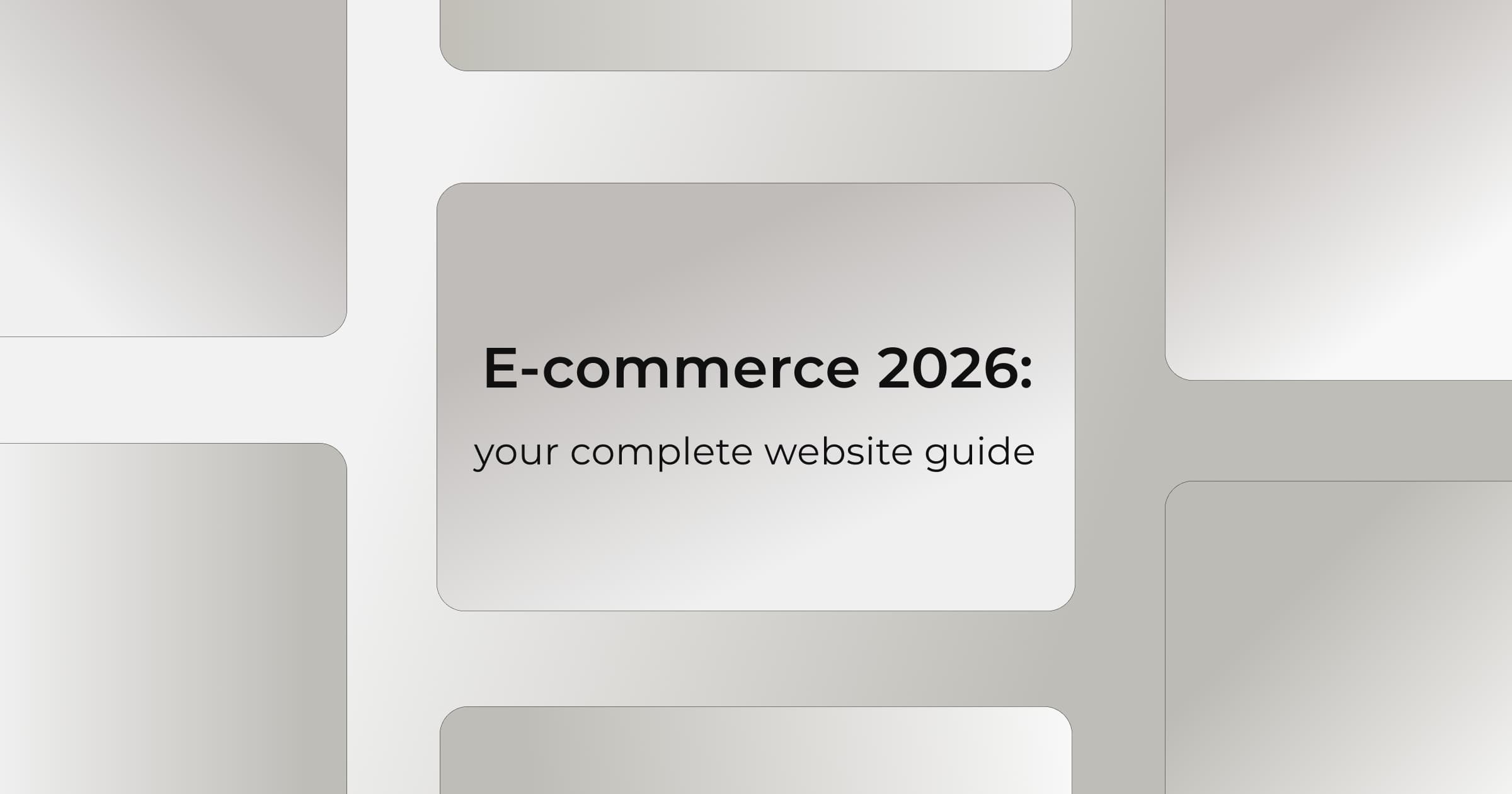
The rapid growth of web technologies has allowed many to join a diverse e-commerce landscape. According to SellersCommerce, the global B2B e-commerce market is valued at approximately USD 32.11 trillion in 2025 and is expected to grow to USD 36.16 trillion by 2026. The competition is fierce, and the natural question arises: how can we stand out?
Follow this guide, and you’ll learn useful tips on how to build an e-commerce website from scratch in 2026.
Steps to Build an E-commerce Website
A digital commerce website is built on several key factors:
- Business model;
- Platform;
- Unique elements;
- Customer experience.
While the specific steps to create an e-commerce website may vary, these four pillars remain consistent across most e-commerce platforms.
The business model determines how new products appear on your digital shelves and how you and your partners generate profit. The platform is the technical backbone of your website. There are many possible options for creating a digital commerce portal.
Customization and personalization are also vital for a successful e-commerce website. Is it visual appeal, new ways of browsing products, or a personalized approach to customer experience? A clear answer to this question will help you gain a solid competitive edge.
Finally, the website should work impeccably, providing a flawless customer experience for different devices.
Identify your e-commerce business model
The E-commerce business model determines how your platform operates, generates profit, and offers tangible value to the customers. There are dozens of unique approaches to the business model, which are a part of one of the four general categories:
- Business to Consumer (B2C)
Business to consumer is a common model that we encounter in everyday life. The model implies direct selling of a product from a business owner to a customer.
This model allows the combination of real and online sales, providing businesses and customers with various connection methods.
- Business to Business (B2B)
Business-to-business models enable direct sales between businesses, such as a soap manufacturer selling to beauty shops. This model reduces infrastructure complexity, allowing businesses to focus on product quality. At the same time, the profits can be lower compared to other models due to the service fees of logistics companies and business partners.
- Consumer to Consumer (C2C)
Consumer-to-consumer is a small-scale model in which a person sells their services or products to another consumer. Usually, these are hand-made or specialized products. While not very profitable, this model can be a perfect jump-start if you wonder how to make an e-commerce website from scratch.
- Consumer to Business (C2B)
The consumer-to-business model usually involves outsourced specialists who sell their services to bigger companies. Photographers, copywriters, and freelance programmers are examples of the C2B model realization. If you are a client in this model, your e-commerce website can become a solid ground for your skills promotion. If you represent a company, a C2B block in the marketplace will expand your business possibilities.
Select an e-commerce platform
Choosing the right e-commerce platform is a key to the question of “How to create e-commerce website?” The first option is to build such a marketplace from scratch. While it may be time-consuming and costly, you will have a platform tailored to your needs and requirements.
Alternatively, you can opt for established e-commerce platforms. They may lack fine-tuned features but have the functionality for a full-fledged digital marketplace.

Scratch
You will need a solid tech stack to build an e-commerce website from scratch. React or Vue.js is an excellent choice for front-end development, and Django and Node.js can provide the right tools for creating backend architecture.
MySQL, MongoDB, and PostgreSQL will be solid database options due to their security and versatility. Finally, Stripe and PayPal APIs can work as integration options.
The list is not exhaustive and serves as an overview of the tools and specialists needed to create a custom e-commerce platform.
Shopify
It ranks among the best e-commerce website development platforms. You get access to a full range of business management tools and options by choosing one of the subscription plans.
It is easy to use and requires minimal technical knowledge. However, if your budget is limited, Shopify may be costly if the business does not meet expectations.
Woocommerce
If you wonder how to build a shopping website without code, Woocommerce is a solid option.
WooCommerce is an extension for WordPress that can enhance a basic website and turn it into a full-fledged digital shop with all the essential features. The basic models of both WooCommerce and WordPress are free, but if you wish for something more advanced, you’ll have to buy a paid subscription.
Webflow
Webflow is a design-oriented solution for building digital marketplaces. It combines intuitive drag-and-drop approach for interface creation with extensive features capabilities, providing the best e-commerce tech stack. It can be challenging for novices to master Webflow but past the initial learning curve lies one of the best tools for digital shops creation.
Begin customizing your site
Personalization is a vital element of your e-commerce platform’s competitive edge. Define your unique value proposition and make it the core of your e-commerce website visually. Show the customers that their needs will be met and your services will help them resolve their issues.
The main goals of the website's customization are calls to action and intuitive navigation that will lead the customer to make a purchase. It may take a few iterations before reaching the desired results, but with a clear vision, you will build a competitive e-commerce platform.
Configure your online store
Even the best image will not save a poorly designed shop. Ensure that your catalogs and product categories are functional. Integrate secure and proven payment gateways, and if you have any fees or shipping taxes, make them clear and understandable for customers.
Usually, pre-built platforms like Shopify have these elements configured by default. Yet, if you’re aiming for a custom platform, these elements should be tested with exceptional attention.
Launch your website
The initial website launch phase can be challenging. The influx of new customers can overload the servers and cause issues with the payment process. It is better to have a dedicated support team to monitor your e-commerce portal's initial launch.
After the rough period ends, it is time to enjoy the benefits. Yet, the support and development of the e-commerce platform is an ongoing process and part of the competition.
What is the cost of creating an e-commerce website?
The cost of an e-commerce website includes the work of specialists in the actual website design and development. If you choose a pre-established platform like Shopify or WooCommerce, the cost of the portal launch and support will be approximately $100 per month.
If you’re aiming to create a custom website, the average cost for the platform is between $5000 and $50,000. This cost covers essential functionality design, development, and integration.

E-commerce Website Best Practices
Launching the website is only half of the work. In the following section, we’ll share the best practices on how to keep your platform attractive to customers and withstand the competition.
Highlight customer reviews
Make the positive reviews from your customers visible. Proof of quality by satisfied clients is a powerful motivator for a visitor to stay and learn more about your value proposition.
Utilize stock images
Stock images are created with professional appeal in mind. They convey necessary ideas and do not take much resources. When used strategically, they can enhance your value proposition and contribute to the platform’s visual appeal.
Incorporate white space on each page
White space helps to make each page less cluttered and highlight important elements, like calls to action or promotion banners. White space helps to create a feeling of comfort during the web portal visit and improves the overall user experience.
Enhance your e-commerce SEO
SEO optimization will improve your portal visibility and attract more customers. Ensure your content is straightforward, easy to read, and conveys messages reflecting your marketplace vision. Shopify and WooCommerce extensions can help with SEO optimization and the platform’s performance.
Establish a strong online presence
Figuring out how to setup your own e-commerce website is only a part of the job. Promoting your platform and highlighting daily activities will help build a strong online presence. Social media channels, blogs, or even a YouTube channel for the website will attract new customers and keep long-time clients informed and motivated to engage with the platform.
Keep up with e-commerce trends
E-commerce does not stand still. Reevaluate your platform’s performance regularly and update the interface, design, or even product delivery logic if necessary. The more comfortable and up-to-date your platform's experience is, the more revenue it will generate.
Start Developing Your E-commerce Skills Now
It may be daunting to start your e-commerce platform in 2026. However, right now is the best time to do so. The number of options and tools available allows everyone to implement their vision of a perfect e-commerce platform with any scope or budget.
And if you want to give your platform a professional touch, our specialists are ready to lend a hand. Contact our support to learn more!
Google Digital Marketing & E-commerce
Google's digital marketing tools are a reliable means for gaining online visibility and evaluating your platform’s performance. Learn more about their applications and integrate them into your platform's work to get better results from each sale.
.png)








